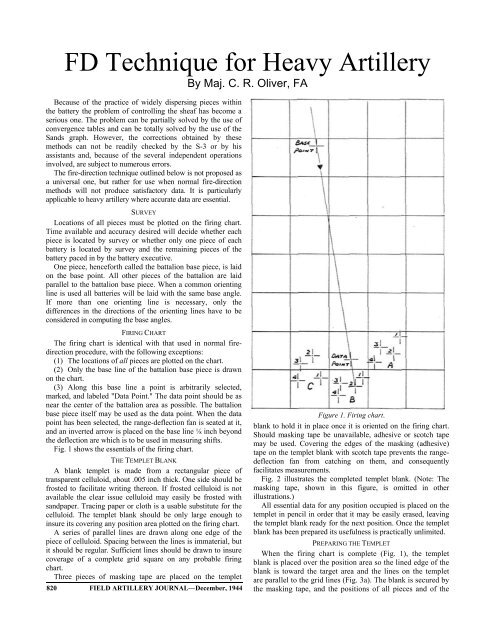the field artillery journal - Fort Sill - U.S. Army
the field artillery journal - Fort Sill - U.S. Army
the field artillery journal - Fort Sill - U.S. Army
Create successful ePaper yourself
Turn your PDF publications into a flip-book with our unique Google optimized e-Paper software.
FD Technique for<br />
Because of <strong>the</strong> practice of widely dispersing pieces within<br />
<strong>the</strong> battery <strong>the</strong> problem of controlling <strong>the</strong> sheaf has become a<br />
serious one. The problem can be partially solved by <strong>the</strong> use of<br />
convergence tables and can be totally solved by <strong>the</strong> use of <strong>the</strong><br />
Sands graph. However, <strong>the</strong> corrections obtained by <strong>the</strong>se<br />
methods can not be readily checked by <strong>the</strong> S-3 or by his<br />
assistants and, because of <strong>the</strong> several independent operations<br />
involved, are subject to numerous errors.<br />
The fire-direction technique outlined below is not proposed as<br />
a universal one, but ra<strong>the</strong>r for use when normal fire-direction<br />
methods will not produce satisfactory data. It is particularly<br />
applicable to heavy <strong>artillery</strong> where accurate data are essential.<br />
SURVEY<br />
Locations of all pieces must be plotted on <strong>the</strong> firing chart.<br />
Time available<br />
and accuracy desired will decide whe<strong>the</strong>r each<br />
piece is located by survey or whe<strong>the</strong>r only one piece of each<br />
battery is located by surv ey and <strong>the</strong> remaining pieces of <strong>the</strong><br />
battery<br />
paced in by <strong>the</strong> battery executive.<br />
One piece, henceforth called <strong>the</strong> battalion base piece, is laid<br />
on <strong>the</strong> base point. All o<strong>the</strong>r pieces of <strong>the</strong> battalion are laid<br />
parallel to <strong>the</strong> battalion base piece. When a common orienting<br />
line is used all batteries will be laid with <strong>the</strong> same base angle.<br />
If more than one orienting line is necessary, only <strong>the</strong><br />
differences in <strong>the</strong> directions of <strong>the</strong> orienting lines have to be<br />
considered in computing <strong>the</strong> base angles.<br />
By Maj. C. R.<br />
Oliver, FA<br />
Heavy Artillery<br />
FIRING CHART<br />
The firing chart is identical with that used in normal firedirection<br />
procedure, with <strong>the</strong> following exceptions:<br />
(1) The locations of all pieces are plotted on <strong>the</strong> chart.<br />
(2) Only <strong>the</strong> base line of <strong>the</strong> battalion base piece is drawn<br />
on <strong>the</strong> chart.<br />
(3) Along this base line a point is arbitrarily selected,<br />
marked, and labeled "Data Point." The data point should be as<br />
near <strong>the</strong> center of <strong>the</strong> battalion area as possible. The battalion<br />
base piece itself may be used as <strong>the</strong> data point. When <strong>the</strong> data<br />
point has been selected, <strong>the</strong> range-deflection fan is seated at it,<br />
and an inverted arrow is placed on <strong>the</strong> base line ⅛ inch beyond<br />
<strong>the</strong> deflection are which is to be used in measuring shifts.<br />
Fig. 1 shows <strong>the</strong> essentials of <strong>the</strong> firing chart.<br />
Figure 1. Firing chart.<br />
blank to hold it in place once it is oriented on <strong>the</strong> firing chart.<br />
Should masking tape be unavailable, adhesive or scotch tape<br />
may be used. Covering <strong>the</strong> edges of <strong>the</strong> masking (adhesive)<br />
tape on <strong>the</strong> templet blank with scotch tape prevents <strong>the</strong> range-<br />
THE TEMPLET BLANK<br />
deflection fan from catching on <strong>the</strong>m, and consequently<br />
A blank templet is made from a rectangular piece of facilitates measurements.<br />
transparent celluloid, about .005 inch thick. One side should be Fig. 2 illustrates <strong>the</strong> completed templet blank. (Note: The<br />
frosted to facilitate writing <strong>the</strong>reon. If frosted celluloid is not masking tape, shown in this figure, is omitted in o<strong>the</strong>r<br />
available <strong>the</strong> clear issue celluloid may easily<br />
be frosted with illustrations.)<br />
sandpaper. Tracing paper or cloth is a usable substitute for <strong>the</strong> All essential<br />
data for any position occupied is placed on <strong>the</strong><br />
celluloid. The templet blank should be only large enough<br />
to templet in pencil in order that it may be easily erased, leaving<br />
insure its covering any position area plotted<br />
on <strong>the</strong> firing chart. <strong>the</strong> templet blank ready for <strong>the</strong> next position.<br />
Once <strong>the</strong> templet<br />
A series of parallel<br />
lines are drawn<br />
along one edge of <strong>the</strong> blank has been prepared its<br />
usefulness is practically unlimited.<br />
piece of celluloid. Spacing<br />
between <strong>the</strong> lines is immaterial, but<br />
it should be regular.<br />
Sufficient lines should be drawn to insure<br />
coverage of a complete<br />
grid square on any probable firing<br />
chart.<br />
Three pieces of masking tape are placed on <strong>the</strong> templet<br />
PREPARING THE TEMPLET<br />
When <strong>the</strong> firing chart is complete (Fig. 1), <strong>the</strong> templet<br />
blank is placed over <strong>the</strong> position area so <strong>the</strong> lined edge of <strong>the</strong><br />
blank is toward<br />
<strong>the</strong> target area and <strong>the</strong> lines on <strong>the</strong> templet<br />
are parallel to <strong>the</strong> grid lines (Fig. 3a). The blank<br />
is secured by<br />
820 FIELD ARTILLERY JOURNAL—December, 1944<br />
<strong>the</strong> masking tape, and <strong>the</strong> positions of all pieces and of <strong>the</strong>

















